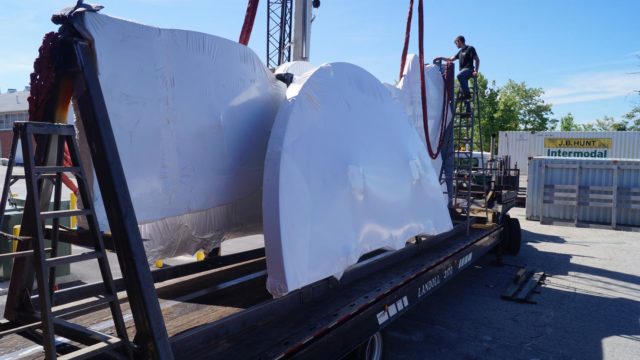What does transporting large scale sculpture have to do with race car design?
You would be in the majority if your answer is “absolutely nothing!”
I’ve contemplated this for many years, and only recently discovered the real answer is “a whole lot more than I thought!”
In race car design, it is essential to produce a car that can handle g-forces induced by high speed turns without catastrophic results. It is by definition, highly engineered mechanical design that takes into account things like camber, castor, toe in/out, Ackermann steering principals and many other arcane rules of race car geometry. These are all concepts that have little to do with shipping a sculpture. However, there is a starting point for a car designer that does have everything to do with shipping a sculpture. That starting point is a grasp of the concept of ‘sprung’ vs ‘unsprung’ weight.

Understanding what is ‘sprung’ and ‘unsprung’ is easy. Does the spring sit on ‘it’? Then it is ‘unsprung’. Does ‘it’ sit on the spring? Then it’s ‘sprung’.
Things like wheels and tires, axels, brake calipers, and the differential are all ‘unsprung’ weight that is in direct contact with the ground. They must be kept in direct contact or the driver will lose control with undesirable results.
Everything else is ‘sprung’. Chassis, engine, transmission, seats, you, and even your coffee and the cupholder, fall into this group.
Dampening the vibrations between the two? Shock absorbers!
All the bumpiness of the road surface would rattle teeth if allowed to transmit directly to the driver. That’s the job of shock absorbers… absorbing shock.
And this is exactly the conundrum we face when shipping a large scale sculpture. How to keep vibrations from rattling the sculpture apart and becoming damaged. And also, how to ship it securely, while keeping ‘all wheels on the ground’!
And this is where the understanding of ‘sprung’ versus ‘unsprung’ becomes utmost important.
To ship a sculpture without damage, it must be sprung. It must have a shock absorber buffering the ride. Foam rubber, moving blankets, carpet remnants, tire scraps, all fit the bill of filling in as the race car’s shock absorber. They will all allow buffering of the vibrations transmitted by the truck bed. They will all allow transit without damages.
All good? …not yet.
The load must also be securely loaded – and that means ‘unsprung’. It must have 100%, locked-down, contact with the truck bed so that the sculpture can’t vibrate itself off. Keep in mind – this is a trucker’s dictate! The load MUST be secured or people get hurt. Every load WILL be 100% secured no matter how much we implore them to allow the ‘shock absorbers’ do their job.
A trucker has one tool in his kit that ensures a load is securely bound. That tool is a ratcheted chain binder, also known as a come-a-long. It does it’s job without any doubt or concern, and renders the shock absorbers useless by squeezing them down to zero. It guarantees damages to the sculpture. To drape this tool over a finished sculpture in order to securely bind it to the truck bed is simply impossible without that outcome.
So why not Nylon Straps? They certainly will not damage the sculpture, and if they are checked often enough can remain tight during transit. Answer: YOU are not driving the truck, and additionally, nylon straps stretch – a lot! There is a different set of motivations for truckers that does not include stopping to check straps every 25 miles as they stretch. They are charged with getting it there by Thursday to collect a payday. Stretch be damned!
The challenge is to get what the trucker – and you – both need and can agree on. He wants a bound, unsprung load, that he does not have to check every 1/2 hour. And you want a cushioned, sprung one that arrives without damage.
It is a violation of the laws of physics to get both outcomes in the same envelope. Ask that of a race car designer and he’ll say, “It cannot be done.”
So there must be two.
Enter the cradle!
No one wants to pay for an extra piece of steel hardware. It’s bespoke for that sculpture and that sculpture ONLY. It can be costly. It must be disposed of after delivery. However, it is the ONLY way to ensure both goals are met and no damages occur.
A well-built cradle can be chain bound to the truck bed and will not require re-tightening every 25 miles to do the job. A well-made cradle can be fitted with all the shock absorber needed to allow the sculpture to comfortably ride without damage. The sculpture can be strapped to the cradle, the cradle can be chain bound to the truck bed, and all can arrive safe and sound.
I call it a ‘binding load’ and a ‘snugging load’. They are not the same. If you keep these principals in mind, things will arrive in much better condition.
Or you can choose to ignore physics…
Please let me know how that works out.
Paul Amaral
President and Founder
Amaral Custom Fabrications, Inc.
